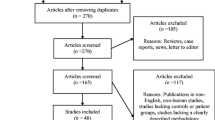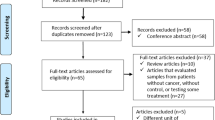Abstract
Data sources Four electronic databases were searched: Medline (OVID), Web of Science, Embase and Scopus. An initial search was carried out in May 2018, and this was updated in September 2020. There was no time restriction on the studies included, and the final data consisted of studies published from 2004-2020.
Study selection The electronic database search yielded 2,764 abstracts, and following de-duplication, 1,873 articles were screened in accordance with the exclusion criteria. In total, 346 articles were selected for full-text screening by four pairs of blinded reviewers and 295 articles were included in the final study. The main objectives of this study were to investigate a suitable biomarker for early detection of oral squamous cell carcinoma (OSCC) and oral potentially malignant disorders (OPMDs), and to assess the relationships between salivary biomarkers and risk factors for OSCC and OPMD. The Newcastle-Ottawa Scale was used for quality assessment. Most studies were considered to have a moderate risk of bias. The publications included fulfilled the following criteria: original research, human subjects with oral cavity cancer, OSCC or OPMD, aged 18 years or over, studies analysing biomarkers in saliva or salivary rinse, and studies published in English.
Data extraction and synthesis Data extraction followed the Preferred Reporting Items for Systematic Reviews and Meta-Analyses (PRISMA) guideline process. The following data parameters were included in the studies chosen for assessment: study design, first author, year of publication, country of study population, age, sample size, gender, salivary biomarkers, method used to analyse the biomarkers, relationships between risk factors and salivary biomarkers, and conclusions.
Results Following evaluation of 295 articles and selection of suitable salivary biomarkers, 28 articles were chosen to further assess interleukins as potential biomarkers and 33 studies were found to report a relationship between salivary biomarkers and risk factors. From the data reported, IL1β, IL6 and IL8 were identified as being statistically significant and most suitable for early identification of OSCC and OPMDs. In smokers, there were significant differences found in certain biomarkers compared to controls. There were statistically non-significant relationships found between biomarkers and alcohol, as well as other risk factors.
Conclusion The authors proposed that a proteomic salivary biomarker panel, including a combination of IL1β, IL6 and IL8, would be suitable for clinical validation for the early detection and screening of OPMDs and OSCC. They have also highlighted the presence of research gaps in the relationship between salivary biomarkers and risk factors for OPMDs and OSCC, and the need for further research to understand the role of biomarkers in disease initiation and progression.
Similar content being viewed by others
A Commentary on
Piyarathne N S, Rasnayake R M S G K, Angammana R et al.
Diagnostic salivary biomarkers in oral cancer and oral potentially malignant disorders and their relationships to risk factors - A systematic review. Expert Rev Mol Diagn 2021; 21: 789-807.

GRADE rating
Commentary
Despite numerous efforts to improve its diagnosis and management, oral cancer remains a substantial public health concern, with lip and oral cavity cancer ranking the sixteenth most common type of cancer in the global cancer statistics in 2020.1 Oral cancers typically have a poor prognosis following diagnosis with reported five-year survival rates of less than 50%.2 Prognosis is dependent on the stage at diagnosis, and early detection has been associated with reduced mortality and a better quality of life. This systematic review attempts to identify a suitable biomarker panel for screening and early detection of oral squamous cell carcinoma (OSCC) and oral potentially malignant disorders (OPMDs), and to study the relationship between salivary biomarkers and risk factors for these diseases.
In this review, the authors followed the PRISMA guidelines and clearly identified the data parameters assessed. The literature search was found to be adequate as four electronic databases (Medline [OVID], Web of Science, Embase and Scopus) were explored. However, grey literature was not included and the search was limited to the English language, meaning relevant studies in other languages may have been missed.
In total, 346 articles were divided between four pairs of trained blinded reviewers for screening of the full text. Disagreements within each pair were resolved by discussion or through involvement of a third reviewer. There was no statistical measurement of inter-reviewer agreement. Overall, 295 articles fulfilled the selection criteria and were included in the final study. There was a variation in the sample sizes of individual studies, ranging from 18-300. The studies assessing interleukins as potential biomarkers for OSCC and OPMDs (28 studies) were published between 2004 and 2020. The years of publication were not clearly stated for studies assessing the relationship of salivary biomarkers and risk factors for OSCC and OPMDs (33 studies). The risk factors assessed included smoking, alcohol, betel quid chewing, viral infections, periodontitis, body mass index, education level, mitochondrial DNA, SLPI protein, mouthwash use and oral health status.
Statistical significance was measured using P values and area under curve (AUC). The results were presented in a narrative format and results of individual studies were provided in tables. Quality assessment was carried out and risk of bias was evaluated using the Newcastle-Ottawa Scale.
Of the studies assessing for potential biomarkers, 52% reported protein biomarkers and thus these were chosen for further analysis. Among proteins, interleukins were chosen by the reviewers as appropriate biomarkers to study. Twenty-eight applicable articles out of 295 were found, and these were all case-control studies. The majority of these were considered to be of fair quality. Interestingly, two of these studies did not include OSCC. From the data reported, IL1β, IL6 and IL8 were identified as being statistically significant and most suitable for early identification of OSCC and OPMDs.
Thirty-three out of 295 articles were found to assess the relationships between biomarkers (including proteins, DNA, RNA, metabolites and microbials) in saliva and risk factors in OSCC and OPMDs. The majority of these were case-control studies and were of fair quality. In smokers, there were statistically significant differences in epidermal growth factor (EGF), loss of heterozygosity (LOH), secretory leucocyte protease inhibitor (SLPI), IL-10, hypermethylation of the promoter region of MGMT gene, and macrophage migration inhibitor factor (MIF) in comparison to former smokers and non-smokers. All biomarkers assessed for the potential association with alcohol (13 studies) and other risk factors showed statistically non-significant relationships.
As the authors have stated, one important limitation of this study is the absence of a meta-analysis. Significant differences were reported in IL1β, IL6 and IL8 levels in OSCC and OPMDs compared to controls. The authors have suggested that these biomarkers used in combination have a high predictive power for OSCC and OPMDs.
It can be summarised that these group of interleukins are strongly associated with OSCC and OPMDs; however, interleukins have a diverse role in inflammation and there are questions regarding their specificity. Therefore, further research is required to assess the specificity of these biomarkers and the usefulness of their application in a clinical setting. Additionally, more research is required to understand the association between biomarkers and risk factors, and the role of biomarkers in the progression of these diseases.
References
International Agency for Research on Cancer. Cancer today. 2020. Available at https://gco.iarc.fr/today/online-analysis (accessed February 2022).
Goldoni R, Scolaro A, Boccalari E et al. Malignancies and Biosensors: A Focus on Oral Cancer Detection through Salivary Biomarkers. Biosensors (Basel) 2021; 11: 396.
Author information
Authors and Affiliations
Rights and permissions
About this article
Cite this article
Elmahgoub, F. Could salivary biomarkers be useful in the early detection of oral cancer and oral potentially malignant disorders, and is there a relationship between these biomarkers and risk factors?. Evid Based Dent 23, 30–31 (2022). https://doi.org/10.1038/s41432-022-0249-8
Received:
Accepted:
Published:
Issue Date:
DOI: https://doi.org/10.1038/s41432-022-0249-8
- Springer Nature Limited




